Are you looking for an orangutan tour? One of the most amazing places to visit in Sabah and a fantastic Borneo orangutan tour is the Sepilok Orangutan Rehabilitation Centre.
The Sepilok Orangutan Rehabilitation Centre began as an initiative of the Sabah Government in the early 1960’s. It was opened in 1964 and has continued to evolve and grow since.
The Malaysian Government has been quite pro-active in the last 50 years in trying to preserve its orangutans, which inhabit east Malaysia (the nation’s capital Kuala Lumpur is located on the Malaysian peninsula)
The Sepilok Orangutan Rehabilitation Centre is one conservation project caring for wild orangutans.
Contents
- Sepilok Orangutan Rehabilitation Centre
Sepilok Orangutan Rehabilitation Centre
History Of The Orangutan
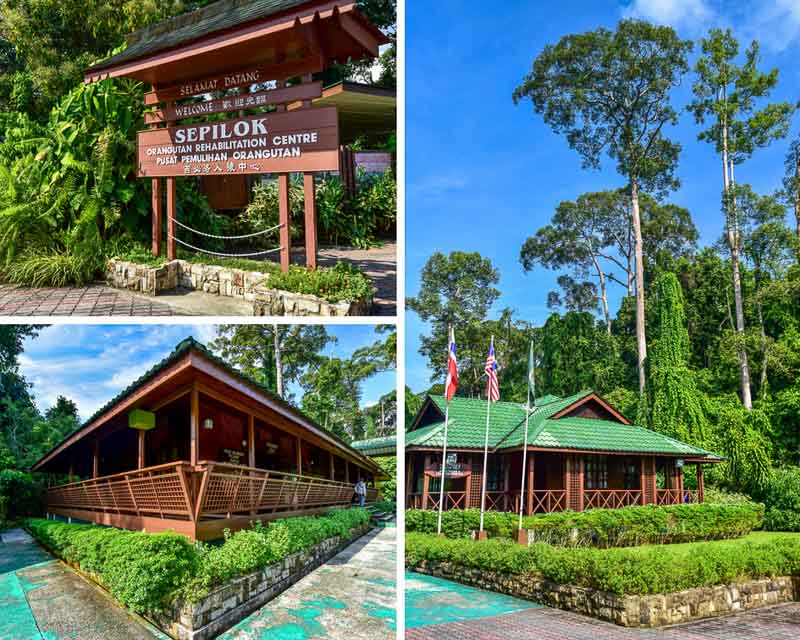
Orangutans are only found in the islands of Borneo and Indonesia’s Sumatra.
In Malay ‘orang’ means a person, ‘utan’ (or ‘hutan’) means forest, aka ‘Man of the Forest’.
These beautiful creatures are now critically endangered.
A hundred years ago, there were approximately 230,000. Currently, there are an estimated 54,000 left in Borneo and 6000 in Sumatra.
- 20 Famous Landmarks in Malaysia
- 30 Things To Do In Kuala Lumpur
- 35 Things To Do In Penang
- Living in Penang As An Expat
- 20 Things To Do In Melaka
- 15 Things To Do In Sabah
- 15 Things To Do In Cameron Highlands
- Malaysia Airlines Business Class Review
- 21 Beaches In Malaysia
- 20 Things to Do In Kuala Lumpur At Night
- 20 Malaysian Cities
Why Is The Orangutan Endangered?
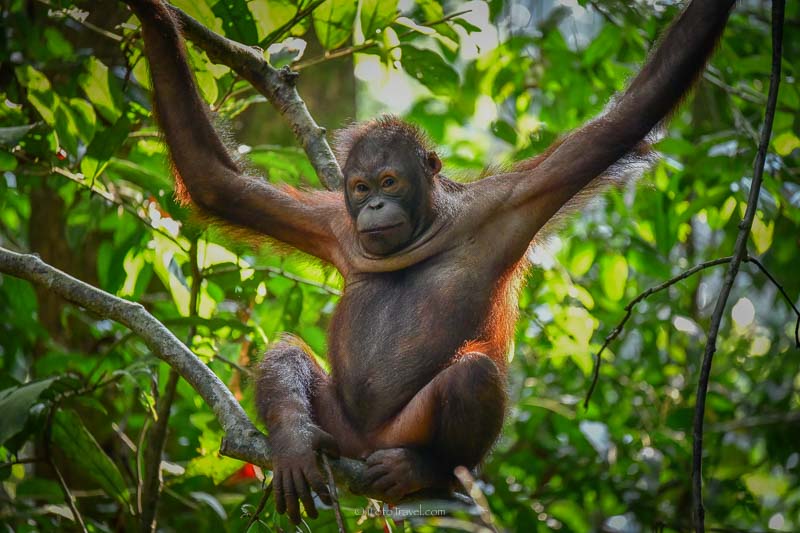
Numbers are becoming severely depleted.
It is rumoured that all the orangutans in the world will be gone in the next two decades at the current escalating rate.
The main reasons the orangutans are endangered are:
1- Habitat loss
Habitat loss has occurred because of deforestation and logging, especially for palm oil plantations and paper production.
Coal mining and agricultural farming also play a part. Both starvation or being killed by forest workers contributes to their demise. And recent forest fires have also been devastating.
2- Pet trade
The black market pet trade has affected numbers but it is still ongoing.
The ‘cute’ baby orang-utans are often taken from their mothers who are killed to do so.
3- Bushmeat
While this has also been illegal for many years now, it is still practised in remote regions.
4- Low reproduction rate
Orangutan females only have one baby and after an 8-month pregnancy, the babies suckle their mothers for up to six years.
So an adult female may only have 3 to 4 pregnancies in her lifetime.
Interesting Facts About Orangutans
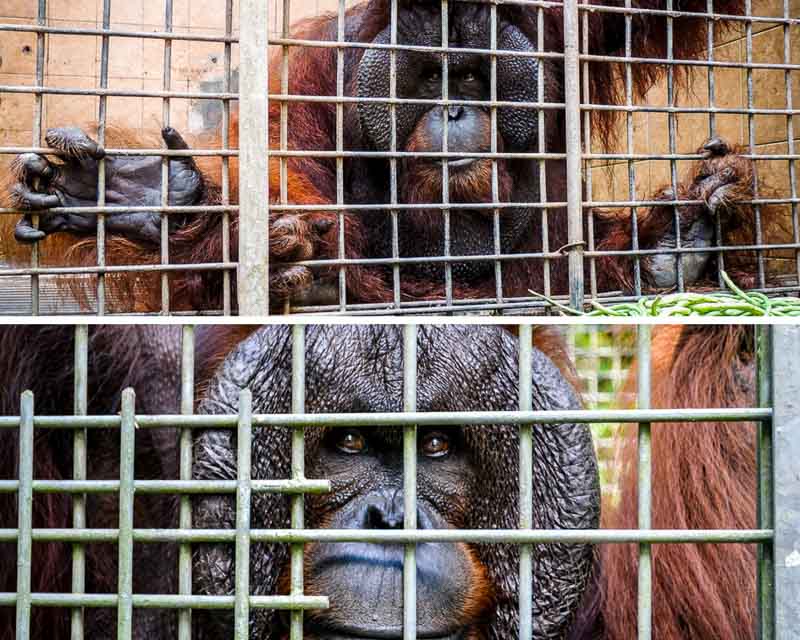
- Orangutans are extremely intelligent and inquisitive.
- Patience and observation is a characteristic of orangutans so it’s not surprising that they share 97% of human DNA; just look into their eyes and you will see this. I was lucky to work with orangutans a few years ago and I experienced their ‘humanity’ first hand. They are so human-like, it’s heartbreaking. To see one stretch out a hand for food while captive in a cage for the rest of its life is soul-destroying.
- In the wild, they have large territories, up to 39 square km for a male. And he will challenge any other male coming into his area, often fighting to severe injury or death. Hence many rescued male orangutans cannot be released back into the wild.
- Orangutans are great apes, not monkeys. They live and eat leaves and fruit mainly but are omnivores.
- They also sleep in the trees. In fact each night, they make a new bed high in the treetops from branches and leaves.
- And they hate rain, often covering their heads with large leaves if they can. In captivity, a rain shower sends them running to hide in shelters.
Sepilok Orangutan Rehabilitation Centre
In Borneo, there is little forest left for them to live and have their territories.
So many conservations hold rescued orangutans in cages with nowhere else to go.
Depending on government policies, some lucky ones may be leased to zoos.
A few have captive breeding programs, but those orang-utans will never be released into the wild.
The Sepilok Orangutan Rehabilitation Centre is the most famous conservation project in Borneo. It was built at the junction of the two main rivers entering Sandakan Bay.
Its mission is to release orphaned, injured or displaced orangutans into the wild.
There are 4294 hectares of surrounding ‘virgin’ jungle, a protected government forest reserve.
The tropical rainforest includes mangroves too and is a natural habitat for orangutans.
Sepilok Orangutan Rehabilitation Centre Nursery
Rescued orphaned or injured babies are brought to Sepilok Orangutan Rehabilitation Centre.
They undergo a thorough medical checkup as orangutans often carry tuberculosis (TB) and other diseases.
These they need to have treated before they can mix with others. Even after treatment for TB, some centres have a policy to never release those back into the wild, in case of reactivation of the disease.
Thus those unfortunate orangutans are destined for a life in captivity, which often means caged for life.
Once medically cleared, the babies enter a ‘nursery’ program.
Here they are taught simple skills like climbing, which leaves to eat and foraging.
Strict human supervision is by long-term carers who may often sleep with their charges.
When a few years old, they migrate into the ‘outdoor nursery’. There they are minimally supervised while they play on outdoor ‘enrichment’ equipment.
This builds their strength and agility on large climbing frames and poles.
They are also allowed access to the forest.
Baby orangutans are very strong and it doesn’t take long for some to climb high into the treetops, swinging naturally from tree to tree.
What To Do At Sepilok Orangutan Rehabilitation Centre
1- Head To The Feeding Platforms
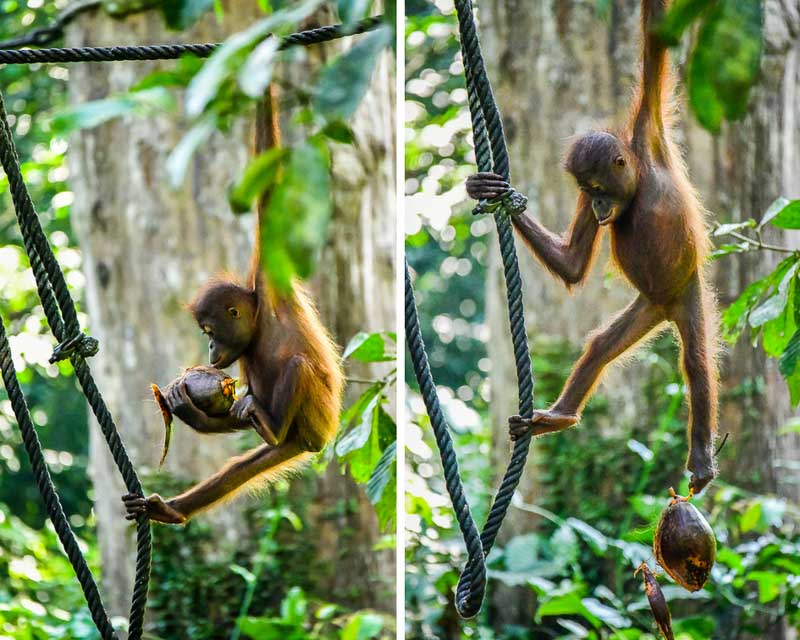
There are regular feeding times at the Centre.
Some of the orangutans released into the forest still supplement their diet by coming down to the feeding platforms for fruit and milk.
This participation is purely at the orangutans wish but most days, some appear and what a sight to see.
We were lucky to witness a mother with her baby.
Both came out of the dense forest and spent nearly two hours at the feeding platform.
Another female came down to feed and even play on the net sheltering our platform.
What amazing proximity to the lucky tourists who witnessed such an awesome event.
2- Hang Out At The Outdoor Nursery
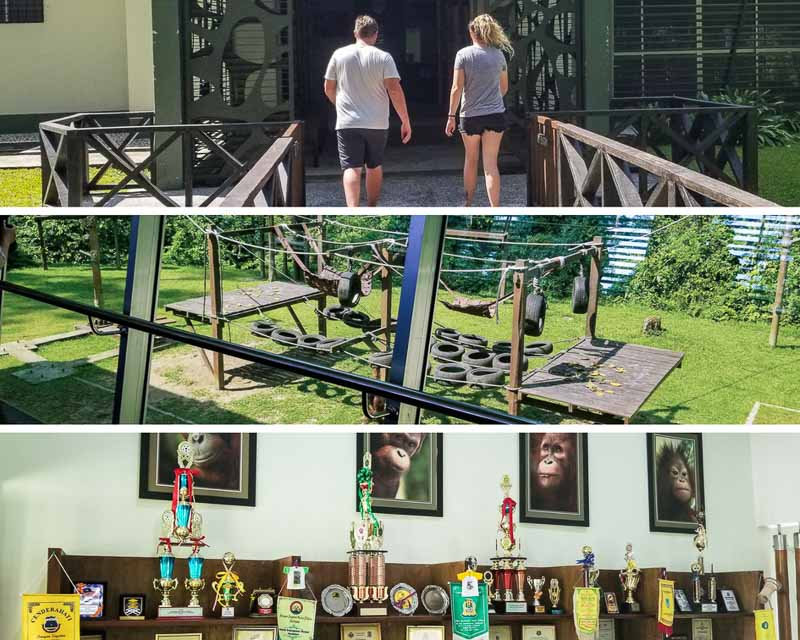
There is also the Outdoor Nursery to visit, which is open all day and you can go there as many times and for as long as you want.
There are two glassed-in areas to look down onto the outdoor play area. One is air-conditioned, the other not. You may ask who on earth would sit in the latter especially in the hot and humid climate of Borneo.
But, depending on the angle of the sun (especially if you are into photography), one room is better than the other.
We sat for an hour or two, totally mesmerized by the antics of at least four or five baby orangutans.
Again these numbers vary as the babies can come and go as much as they please. There is a keeper with a watchful eye on them though.
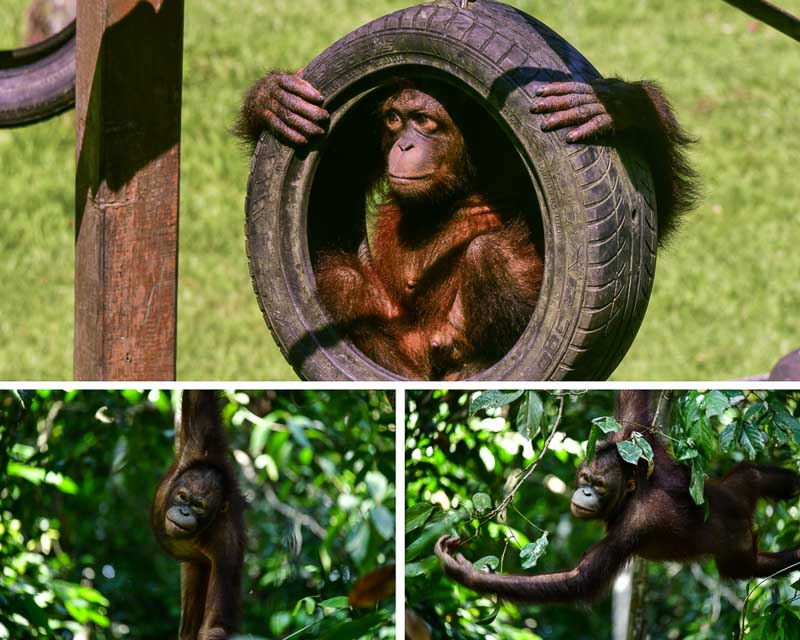
3- Stroll Along The Rainforest Boardwalks
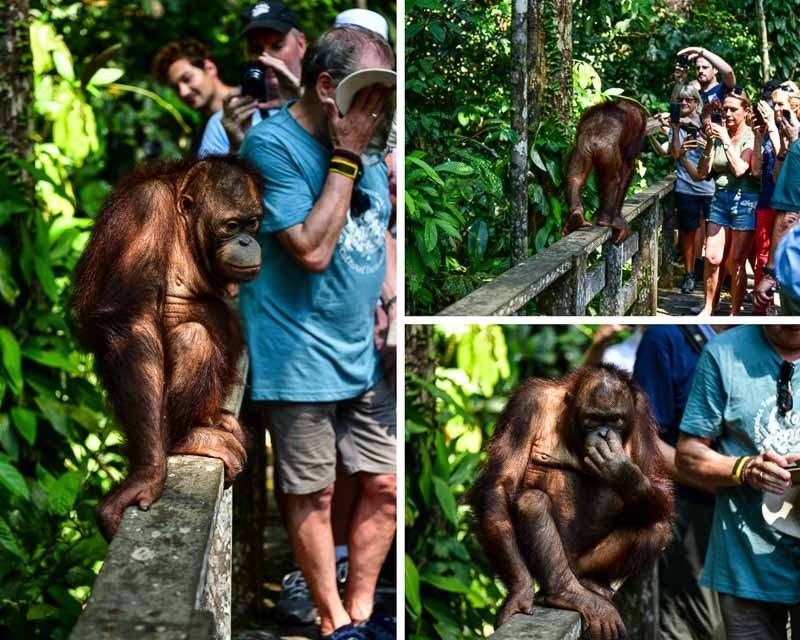
Apparently, they are known to try to take bags or cameras from tourists. So leave all loose belongings in personal lockers at the entrance.
And don’t discount seeing ‘wild’ orangutans in the forest as you walk along the boardwalks to the nursery or platforms.
The time we visited, it was not uncommon to have an ‘encounter of the orangutan kind’.
Twice we came across a keeper on one of the boardwalks. Keeping a watchful eye on a protégé as it swang from tree to tree, he repeatedly shouted to it to stay away. But this one young male even came right down onto the handrail next to us.
It turned out to be one of the ‘rat pack’ of a group of young male orangutans. One with a ‘naughty’ nature and known for not listening to its keeper.
“They are so human-like, it’s not funny,” I thought to myself. We watched on, holding our breath so as not to scare it away.
And all he wanted to do was get a closer view of us, looking at him.
Hilarious!
Visiting Sepilok Orangutan Rehabilitation Centre
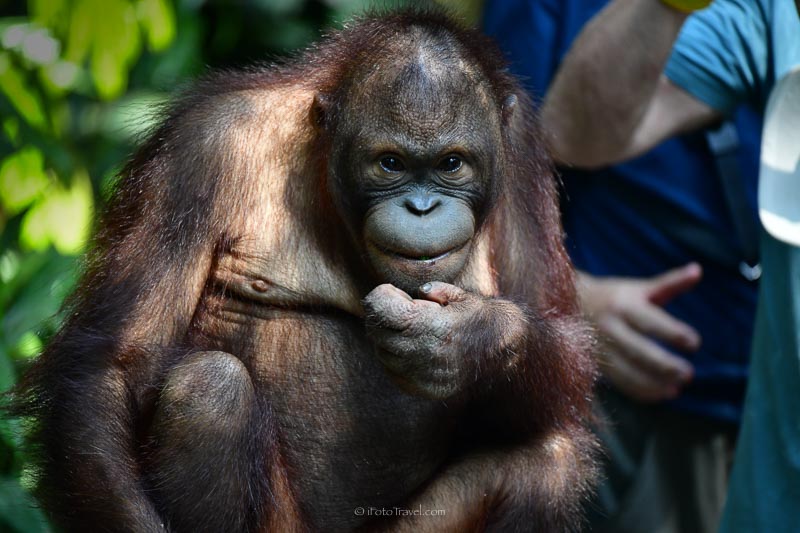
How Much Does It Cost?
The Sepilok Orangutan Rehabilitation Centre is open from 9 am to 4 pm and only costs about AUS $10 (RM 30) for non-Malaysian tourists, but there is an additional camera fee of approx. AUD 3 (RM 10) – smartphone cameras are exempt though.
Where is Sepilok Orangutan Rehabilitation Centre?
The Centre is 45 minutes from Sandakan.
There are regular public buses costing around AUD 1 or you can hire a car quite cheaply too.
If you are staying in Kota Kinabalu, it is a five-hour bus trip to Jalan Sepilok, 2.5km from the Centre.
You can fly in less than an hour and take a taxi for the short ride from the airport.
Where To Stay near Sepilok Orangutan Rehabilitation Centre
If you don’t want to make the trek to the Sepilok Orangutan Rehabilitation Centre, you can stay in the nearby accommodation.
There are at least six accommodation houses including the Sepilok Jungle Resort, Sepilok Forest Edge Resort and Sepilok Nature Resort.
The first two actually border the forest of the Centre and are only five mins away, making staying there easy to explore nighttime activities such as jungle walks.
There are also cheaper places to stay in Labuk or Sepilok at B&B’s.
What Else Can You Do at Sepilok Orangutan Rehabilitation Centre
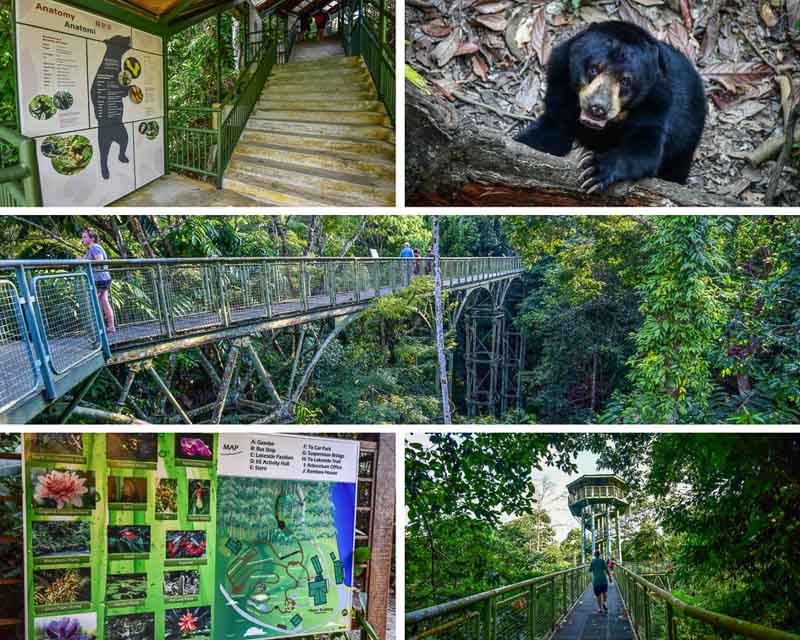
As well as daytime orangutan-based activities, there are short and long rainforest trail walks, some up to 5km. And night time walks are also available.
Right next to the centre with a shared car park is the Bornean Sun Bear Conservation Centre.
Established in 2008, this is a great Sandakan attraction.
See beautiful rescued sun bears, the world’s smallest bear, in their natural habitat, and visit the Labuk Bay Proboscis Monkey Sanctuary.
There’s also the Gomantong Caves.
A great educational centre and a researcher’s dream where we can observe these vulnerable species, whose numbers have declined 30% in the last few decades.
And a short 2km drive away is the Rainforest Discovery Centre where you can experience rainforest ecology and biodiversity by wandering through a network of rainforest trails, day or night. Or check out the 347m long canopy walkway to see over 300 species of tropical birds.
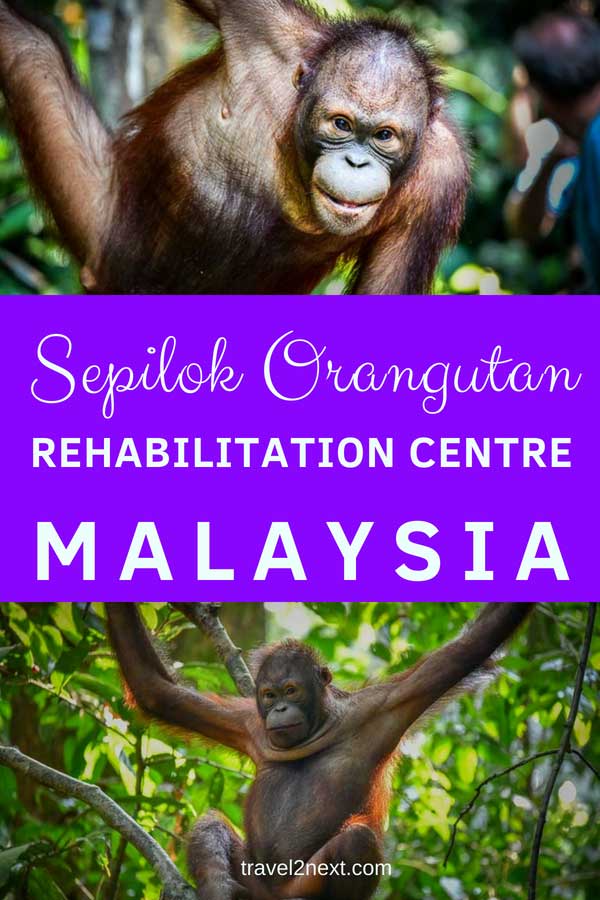
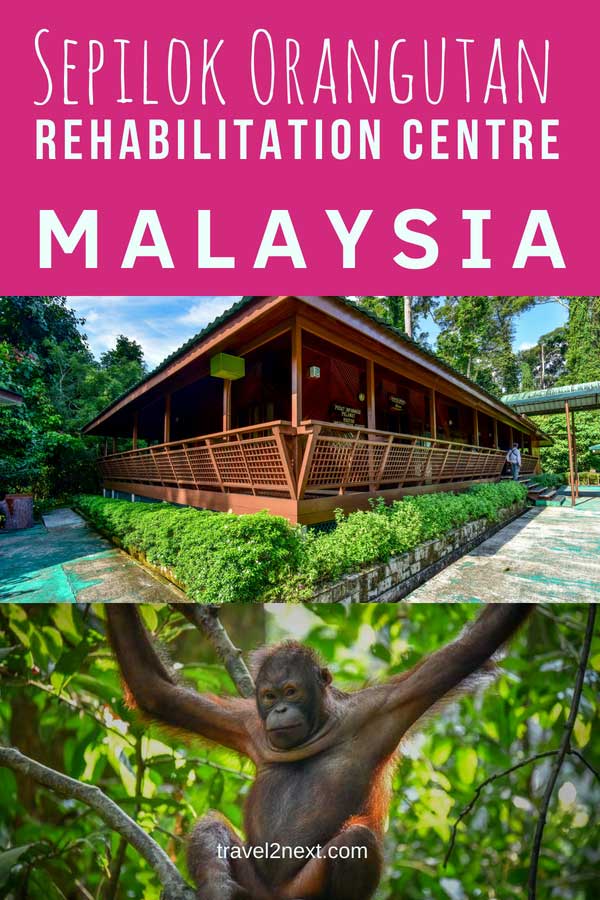
Plan Your Trip

Rent A Car – Find the best car rental rates at Discover Cars. They compare car hire companies to provide you with the best deal right now.

Find A Hotel – If you’re curious about this article and are looking for somewhere to stay, take a look at these amazing hotels.

